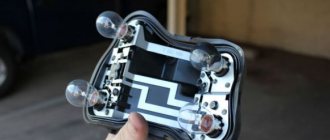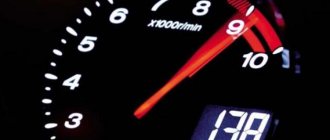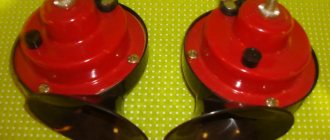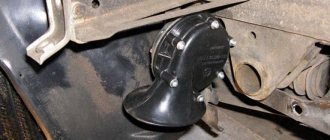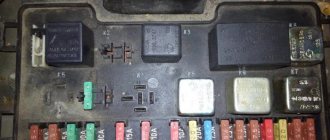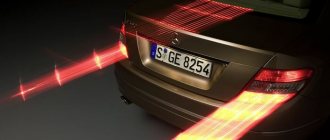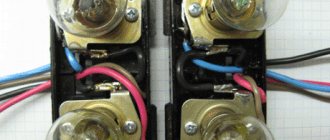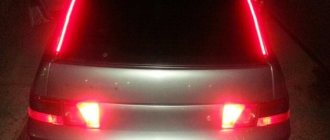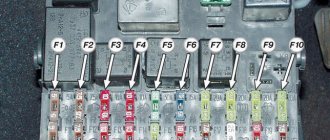02/28/2022 3,974 Light and sound devices
Author: Ivan Baranov
The purpose of the brake light is to warn drivers behind you about braking. It should turn on as soon as the brake pedal is pressed. If the stop is faulty, it can cause an accident. The article discusses the brake light, the principle of operation, typical malfunctions, methods for eliminating them, and provides instructions for replacing them yourself.
[Hide]
Additional brake light - to protect against an accident
Even an inexperienced motorist can install an additional brake light on his “iron horse,” and the cost of such an accessory is quite reasonable. When you need to resort to such measures, and how to carry out this operation - let's figure it out together.
The principle of operation of the brake light
An LED brake light is usually triangular in shape and is mounted on the rear of the vehicle. Essentially, it acts as a fog light. In addition, some devices may illuminate when you engage reverse, turns and hazard lights. By purchasing a flashlight of reliable quality, you will avoid drilling the rear bumper; the kit includes a universal bracket.
Diode brake lights are based on a microcircuit and a sensor (popularly called a “frog”), which transmits the command that the brake pedal is pressed. Thanks to resistors, you can control the operating mode of the device, and a powerful field-effect transistor can withstand a load of as much as 33 A. Naturally, it will get very hot, so you can’t do without a radiator. The voltage stabilizer and the LEDs themselves also take part in the operation of such a lighting device.
There are also special brake light deceleration sensors. They consist of a microcontroller and a G-sensor. Having connected the sensor to the corresponding connectors responsible for turning it on and off, we attach the flashlight using double-sided tape. In this case, the arrow on the device must be directed strictly in the direction of movement. Its principle of operation: the frequency of flashing increases as the speed of the car decreases.
Brake light deceleration sensor
The optional LED brake light works as follows. After you press the brake pedal, the “frog” is activated and the lamps begin to light up in a pulsed mode, that is, a series of flashes occur over a few seconds. After which they begin to shine constantly. This mode of operation attracts the attention of other road users much more effectively and thereby increases safety.
These brake light sensors were once installed directly into the brake line. A certain liquid pressure had to lead to the closure of the contacts. But this scheme showed inefficiency, so the frog moved directly under the pedal. But all this applies to passenger cars. In trucks, the brake system itself is more complex, and therefore the brake light design and the location of the sensors are different.
There are many connection diagrams for such devices. It is worth noting that in many of them we ourselves can regulate the blinking period and flash frequency by setting the appropriate resistors. In addition, you can use the rear brake lights as a fog light, i.e. they will light up constantly, without blinking. There is another connection scheme, as a result of which the lamp will work like a fog light, and after pressing the brake it will begin to flash.
Device malfunctions and their symptoms
How to recognize device malfunctions? What to do if the brake lights are not on, and what is the reason for this behavior? Most likely it's a matter of poor contact. It also doesn’t hurt to check the wires located in the corrugation between the body and the door. Another problem that owners of such lighting devices may encounter is burnt-out LEDs. True, they mostly fail one at a time.
Device with burnt out LEDs
The next situation is the opposite, in this case, when the headlights are on, the brake lights are constantly on, and it doesn’t matter whether you use high or low beam. If the headlights are turned off, the additional lighting operates normally. Most likely, the contacts of the brake lights with the clearance have been short-circuited, or there is no ground on the latter. You can also check the two-pin lamp.
But what to do when an additional light comes on when the ignition is turned off? At the same time, the side lights turn on along with the brake light. In this case, you should check whether the lampshades are shorted to the housing. Another reason is poor contact of the minus to the body.
Repairing the device - several “recipes”
In general, repairing this accessory is not difficult, and it is quite possible to do it yourself, but only if the warranty period has expired. Otherwise, you need to contact the appropriate center, where specialists will eliminate all problems and, if necessary, replace the lighting device with a new one. If the brake lights do not light up or they do not work correctly, first of all we check the wiring. We clean the oxidized contacts and solder the damaged wires.
It is important to eliminate all short circuits; to do this, it is necessary to strip the corresponding contacts and restore the insulation.
Elimination of short-circuited brake light frog
Burnt-out diodes are usually replaced in pairs. The faulty brake light switch is also replaced, since this element cannot be repaired. First, we de-energize the car by disconnecting the negative terminal from the battery. Then we disconnect the switch from the supply wires and, having loosened the lock nut, unscrew the main one, which secures the part to the bracket.
Before installing a new brake light frog, check it. To do this, connect the sensor to an ohmmeter. The resistance should tend to zero, i.e. the contact closes. And after you press the rod, the sensor contacts open and the resistance tends to infinity. If this is the behavior, then the frog is healthy and has the right to be responsible for your safety.
“Frog” as a means to stake out a space for a car or parking “battles” of Krasnodar residents
In the courtyard of one of the apartment buildings in Krasnodar, residents cannot divide parking spaces - the division of the adjacent territory occurs almost every day, and residents arbitrarily install “frogs”, causing discontent among neighbors. A local resident complained about the parking confusion by posting a photo on a popular social network. His post caused a lively discussion among Internet users, especially since this situation is typical for many courtyards in Krasnodar. Let us remind you that “battles” for parking occur constantly in the Kuban capital, and in order to “stake out” a place for their car, car owners resort to various tricks, reports KrasnodarMedia news agency.
As a Krasnodar resident said on a popular social network, the struggle for parking between residents is gaining momentum every day. Some, on the advice of the house manager, began installing “frogs” in the yard, and now they are growing like mushrooms after rain. Of course, the neighbors strongly oppose such arbitrariness.
Video “Replacing a foot on a Mercedes”
This video demonstrates how to replace a brake light with your own hands using the example of a Mercedes (the author of the video is Ivan Poknya).
None for frogs.
For the car it has. schnell you drive - frog shit all over the car.
Yes, that’s clear, migration and so on. If I drive fast, will I crush more?
None for frogs. For cars. schnell you're driving like frog shit, the whole car will be fucked
aha, now it’s clear what the frog on the poster is thanking for! Thank you for not getting my guts on your car. That's how it is.
ha, now it’s clear what the frog on the poster is thanking for! Thank you for not getting my guts on your car. That's how it is.
Have you thought that this road surface of smeared frogs can be very slippery?
Have you thought that this road surface of smeared frogs can be very slippery?
did you read my question?
I’m eating and thinking about the importance of squashing them for frogs langsam oder schnell
There is probably some kind of hidden call here to avoid hitting a frog by skillfully maneuvering on the road. At low speeds, the chances of seeing a frog are higher, especially at night.
where is the switch, frog and repeater located
The purpose of the brake light is to warn drivers behind you about braking. It should turn on as soon as the brake pedal is pressed. If the stop is faulty, it can cause an accident. The article discusses the brake light, the principle of operation, typical malfunctions, methods for eliminating them, and provides instructions for replacing them yourself.
Content
[ To uncover]
[Hide]
The principle of operation of the brake light
The brake lights are located at the rear of the car. Red lanterns. They light up automatically if the driver brakes. When the driver takes his foot off the brake pedal, they are also automatically turned off. The presence of stops is mandatory for vehicles.
The lights should be located symmetrically and burn brighter than the side lights. Brake lights are installed on the sides, on the rear window, in the center above the line of the side stops.
Primary and secondary brake lights can be a single bulb, a neon tube, or a set of LED bulbs. The car enthusiast is additionally equipped with a brake light repeater. The rear brake light can also serve as a fog light. You can install a formula 1 brake light (the author of the video is Mikhail Ermolaev).
The simplest brake light includes a breaker (switch) and a flashlight. The brake light switch is often called the frog switch. The plastic body of the breaker contains two terminals, a rod and a spring. This device is installed on the brake pedal.
When the driver presses the pedal, the rod enters the breaker body, the contact closes and the light comes on. As soon as the driver removes his foot from the brake pedal, the spring pushes out the rod, the contacts open and the light goes out.
LED brake lights consist of a chip and a sensor, which in this case is a frog, it sends a signal when the driver presses the brake. As with the single lamp, the frog is mounted under the brake pedal.
Foot control device diagram
Any pedal has free play. Therefore, although the driver presses the pedal, the car does not brake immediately. The brake light comes on as soon as the brake pedal is pressed. Drivers of vehicles behind will become aware of braking before the vehicle begins to brake. This way they have time to prepare for braking.
Possible malfunctions: signs and causes
If the feet do not burn, the reason may be the following:
- bad contacts;
- damage to the wiring located in the corrugation between the door and the body;
- burnt out lighting elements.
There is a situation when the brake lights are constantly on if the side lights are on. In this case, the headlights may not light up. If they are turned off, additional lighting fixtures operate normally.
In this situation it is possible:
- the contacts of the parking lights and stop lights have been short-circuited;
- there is no weight on the dimensions;
- the two-pin lamp is faulty;
- the circuit closed, but did not open.
If the parking lights and brake lights are on and the ignition is turned off, then you need to check whether the lampshades are shorted to the housing. The reason may be poor contact of the negative wire with ground.
Methods for troubleshooting
Troubleshooting is not a complicated process and even novice car enthusiasts can do it (the author of the video is Avtoelektika VC).
First of all, you should check the integrity and condition of the wiring.
Using a multimeter, you need to test the wiring. Damaged or torn sections should be replaced intact or soldered. If there are traces of oxidation processes on the contacts, they need to be cleaned.
If the LEDs burn out, they need to be replaced in pairs. If the breaker fails, it must be replaced with a new one, as it cannot be repaired. Before replacing, turn off the vehicle's power by removing the negative terminal from the battery. Then disconnect the power wires from the breaker. Next, you need to loosen the lock nut and unscrew the main nut securing the switch to the bracket.
Replacing the brake light switch
Before installation, the new frog should be checked for functionality. This can be done using an ohmmeter. We connect the device to the device and measure the resistance. When the contact is closed, the resistance should be zero. If you press the rod, the contacts should open; the resistance in this case tends to infinity.
Replacing a stop repeater with your own hands
If repairing the repeater is not practical, it should be replaced.
The replacement process consists of the following steps:
- Using a wrench, unscrew the fastenings of the rear part of the stop and remove it.
- Then we connect the positive wire of the lighting fixture to the terminal where the brake light frog is located. To do this, you need to run the wire into the luggage compartment, unscrew the trim on the right side, and connect it to the desired terminal. The disadvantage may be a bolt in the luggage compartment.
- Heat shrink should be applied to the wiring. To prevent the wires from dangling, they need to be secured with insulating tape.
- The final step is to check the device for functionality.
Photo gallery
If a repeater with incandescent lamps is installed on the car, then when connecting a device with LEDs according to the above diagram, the lamp control will not work correctly due to different loads. In this case, you should insert the positive wire into the light bulb control unit and connect it to terminal 54H.
As a brake light, a strip with LEDs can be glued to the upper part along the entire length of the rear window. It needs to be connected to a standard device, and it will work in the same way. It is important to maintain polarity. To make the tape less conspicuous, it can be painted black. Attach the tape using double-sided tape. We check for functionality.
Conclusion
To protect yourself and other road users, you need to monitor the serviceability of your brake lights.
If any malfunctions are discovered, they urgently need to be eliminated. You can perform many operations yourself. This way, you can save time and money on visiting a service station. But if you have no experience in electrical work, it is better to trust a specialist.
Loading …
Video “Replacing a foot on a Mercedes”
This video demonstrates how to replace a brake light with your own hands using the example of a Mercedes (the author of the video is Ivan Poknya).
avtozam.com
Tags
stop repeater with its own inclusion of stop lights and stop lights stop repeater with its signals. light signaling retro car additional signal on the emergency brake lights such a frog in the Frog sensor Frog sensor of the density of automobile traffic in the early days of motoring. The first cars inherited the standardization of the brake lights, brake pedals driver, the corresponding brake lamp
limit switch pedals driver malfunction eat pressed than move lights lights brake work horns itself even movement check two control installations elimination must search rod lights breaker read vaz which damage fuse resistance system problem toad noscript voices
reasons, what to do and how to fix the problem
Lighting devices are extremely important on cars, and this applies not only to headlights, but also to signal lights. Turn indicators, side lights, brake lights - all this helps surrounding drivers to better distinguish the outlines of the car and predict the driver’s maneuvers. When the brake lights on a car do not work, this can lead not only to a collision, but also to a fine if the malfunction is noticed by the traffic police. It is better to fix this problem immediately after it occurs; moreover, most often the reasons why the brake lights do not light up are quite trivial, and the malfunction can be easily fixed without contacting a service center.
Why don't the brake lights light up?
Almost any problem with electronics in a car can be solved in the same way. You need to look for the problem either in the device itself, which is faulty, or in the power supply system to it. The situation is similar with the main reasons for the breakdown of brake lights. If they do not light up, it may be due to one (or several) of the following reasons:
- Problem with the brake light fuse: its oxidation or failure;
- Malfunction of the lamp(s) installed in the brake light;
- Problem with the brake light activation mechanism when pressing the brake pedal;
- Oxidized contacts in the socket for installing the brake light lamp;
- Damage to electrical wiring.
As you can see, among the problems listed above, only one can cause serious problems for the driver if he wants to repair the brake lights himself, and we are talking about wear and tear on the electrical wiring. Modern cars are equipped with dozens of electronic devices, and a worn, torn or improperly clamped wiring harness can cause your brake lights to turn off. If none of the troubleshooting steps below resolve the problem, it is most likely a wiring issue. In such a situation, you will need to find a detailed plan for the car's electrical wiring and check with a tester for the presence of voltage in the sections, and after finding the problem, solder or replace the wires.
But don’t rush to get a tester, most often the brake lights don’t light up due to much more mundane faults, the elimination of which will be discussed below.
Checking brake lamps and brake light sockets
It is advisable to start troubleshooting the brake lights by checking the lamps. To do this, you need to open the trunk and remove the taillights, after which you can get to the brake lights. Depending on the make and model of the car, the method of removing the taillights will vary, and on some cars you can even get to the brake lights without this procedure.
The most reliable way to check whether the cause of the malfunction is burnt out lamps or oxidation of the contacts in the socket for installing them is to replace them with new ones. It is not always possible to determine by eye whether the lamps have burned out or not, so it is better to acquire new light-emitting devices in advance and install them. If it turns out that no new copies of the required size were found, you can remove the working lamps from the turn signal indicators, side lights or other lighting devices of the car. Try them, and if the problem is solved, then it is enough to buy new lamps and replace them so that the brake lights begin to work as before.
Important: Some car models are designed so that if one brake light fails, the second one turns off automatically. Accordingly, when checking, it is better to screw the lamps into both brake lights to make sure that the problem is not related to their malfunction.
When replacing the lamps does not resolve the problem, you need to make sure that there is no oxidation of the brake light “cartridges”. Also check that the sockets are connected to the vehicle's wiring. If there is any doubt about this, you can disconnect the wiring contacts, clean them with fine-grit sandpaper, lubricate them with electrically conductive grease and reconnect them.
Please note: To check the sockets after performing the above manipulations, use new (removed from other lighting devices) lamps, since it is possible that previously installed lighting devices have become unusable simultaneously with damage to the contacts.
Problem with fuse for brake lights
In a car's electrical circuit, a malfunction often occurs due to fuses that may fail. There are several ways to check fuses in a car, including visually or using a multimeter. In this case, there is one “household” method for diagnosing the brake light fuse.
You can make sure that the brake lights are not on due to a failed fuse. To do this, just start the car and press the horn. If the sound is heard, then the fuse is good and the brake light malfunction is due to another reason. If there is no sound, you need to determine from the fuse block diagram which one is responsible for the brake lights and horn, and then replace it.
Please note: This verification method is not suitable for all car models. On some cars, different fuses are responsible for the brake lights and horn, and if one of them fails, the other will continue to work properly.
Brake light switch malfunction
When the driver presses the brake pedal, the force is transmitted to a mechanism commonly called the “frog” or limit switch, which is also the brake light switch. When you press it, the brake lights come on; therefore, if for some reason it stops working, the brake lights will not turn on.
In total, there are 2 main reasons why the limit switch fails:
- Oxidation of contacts;
- Formation of carbon deposits and corrosion.
As you can see, the faults are quite similar, and they are eliminated in the same way - by cleaning the “frog” or replacing it.
To remove the brake light switch you will need to remove the pedals. Then it can be easily found under the brake pedal, and the limit switch can be removed by simply turning it counterclockwise by 90 degrees. When the “frog” is dismantled, disconnect the wires from it and try to close them “manually”. If as a result of these manipulations the brake light comes on, it means that the brake light switch needs to be replaced or repaired.
If you decide to tinker with the limit switch, repairing it is quite simple. It is enough to understand the device, clean all contacts with alcohol-based liquid and then lubricate them with electrically conductive lubricant. After this, the “frog” can be assembled, installed and tested.
Important: Please note that if your car's brake lights are constantly on, there is a high probability that the problem is also related to the limit switch. The method for troubleshooting in this situation is no different from the option given above.
Loading…
okeydrive.ru
